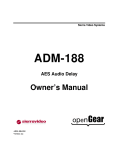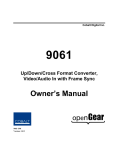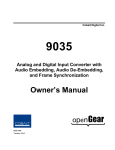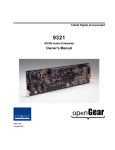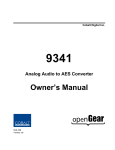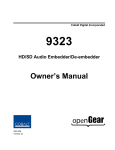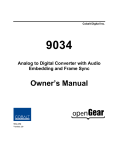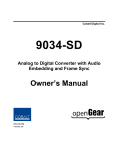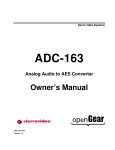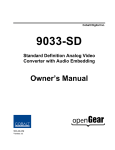Download Cobalt Digital Inc AES Audio Delay 9301 Owner`s manual
Transcript
Cobalt Digital Inc. 9301 AES Audio Delay Owner’s Manual 9301-OM Version: 2.1 9301 • AES Audio Delay Owner’s Manual • • • • • Cobalt Part Number: 9301-OM Document Version: 2.1 Printed in the United States. Last Author: SJK Printing Date: 02/29/08 1:14 PM The information contained in this Owner’s Manual is subject to change without notice or obligation. Copyright © 2008 Cobalt Digital Inc.. All rights reserved. Contents of this publication may not be reproduced in any form without the written permission of Cobalt Digital Inc.. Reproduction or reverse engineering of copyrighted software is prohibited. Notice The material in this manual is furnished for informational use only. It is subject to change without notice and should not be construed as a commitment by Cobalt Digital Inc.. Cobalt Digital Inc. assumes no responsibility or liability for errors or inaccuracies that may appear in this manual. Trademarks Page 2 of 24 • is a registered trademark of Ross Video Limited. • • is a registered trademark of Cobalt Digital Inc. All other product names and any registered and unregistered trademarks mentioned in this manual are used for identification purposes only and remain the exclusive property of their respective owners. 9301 Owner’s Manual • (V 2.1) Important Regulatory and Safety Notices Before using this product and any associated equipment, refer to the “Important Safety Instructions” listed below so as to avoid personnel injury and to prevent product damage. Products may require specific equipment, and /or installation procedures be carried out to satisfy certain regulatory compliance requirements. Notices have been included in this publication to call attention to these specific requirements. Symbol Meanings This symbol on the equipment refers you to important operating and maintenance (servicing) instructions within the Product Manual Documentation. Failure to heed this information may present a major risk of damage or injury to persons or equipment. The symbol with the word “Warning” within the equipment manual indicates a potentially hazardous situation, which if not avoided, could result in death or serious injury. Warning The symbol with the word “Caution” within the equipment manual indicates a potentially hazardous situation, which if not avoided, may result in minor or moderate injury. It may also be used to alert against unsafe practices. Caution The symbol with the word “Notice” within the equipment manual indicates a situation, which if not avoided, may result in major or minor equipment damage or a situation which could place the equipment in a non-compliant operating state. Notice This symbol is used to alert the user that an electrical or electronic device or assembly is susceptible to damage from an ESD event. ESD Susceptibility Important Safety Instructions Caution This product is intended to be a component product of the openGear frame. Refer to the openGear frame Owner’s Manual for important safety instructions regarding the proper installation and safe operation of the frame as well as it’s component products. Warning Certain parts of this equipment namely the power supply area still present a safety hazard, with the power switch in the OFF position. To avoid electrical shock, disconnect all A/C power cords from the chassis' rear appliance connectors before servicing this area. Warning 9301 User Manual • (V 2.1) Service barriers within this product are intended to protect the operator and service personnel from hazardous voltages. For continued safety, replace all barriers after any servicing. This product contains safety critical parts, which if incorrectly replaced may present a risk of fire or electrical shock. Components contained within the product’s power supplies and power supply area, are not intended to be customer serviced and should be returned to the factory for repair. To reduce the risk of fire, replacement fuses must be the same type and rating. Only use attachments/accessories specified by the manufacturer. Page 3 of 24 Environmental Information The equipment that you purchased required the extraction and use of natural resources for its production. It may contain hazardous substances that could impact health and the environment. To avoid the potential release of those substances into the environment and to diminish the need for the extraction of natural resources, Cobalt Digital encourages you to use the appropriate take-back systems. These systems will reuse or recycle most of the materials from your end-of-life equipment in an environmentally friendly and health conscious manner. The crossed-out wheeled bin symbol invites you to use these systems. If you need more information on the collection, reuse, and recycling systems, please contact your local or regional waste administration. You can also contact Cobalt Digital for more information on the environmental performances of our products. Page 4 of 24 9301 Owner’s Manual • (V 2.1) Contents Introduction 6 In This Chapter...........................................................................................................................6 A Word of Thanks......................................................................................................................6 Overview....................................................................................................................................6 Supported Audio Formats ..........................................................................................................7 Discrete AES Audio Input ...........................................................................................7 Discrete AES Audio Output.........................................................................................7 Inputs and Outputs .....................................................................................................................7 Signal Timing.............................................................................................................................7 Functional Block Diagram .........................................................................................................8 Documentation Terms ................................................................................................................8 Installation and Setup 9 In This Chapter...........................................................................................................................9 Static Discharge .........................................................................................................................9 Unpacking ..................................................................................................................................9 Rear Module Installation (Optional) ........................................................................................10 Rear Modules Available for 9301 ............................................................................................11 Board Installation .....................................................................................................................12 Card Control and Status ...........................................................................................................13 Card Status.................................................................................................................13 Menu Navigation .......................................................................................................13 Menu Structure.........................................................................................................................13 Factory Default Settings.............................................................................................16 Remote Control 17 In This Chapter.........................................................................................................................17 DashBoard Control System Software.......................................................................................17 Technical Specifications 19 Service Information 20 In This Chapter.........................................................................................................................20 Troubleshooting Checklist .......................................................................................................20 Warranty and Repair Policy .....................................................................................................21 Ordering Information 22 9301 and Related Products.......................................................................................................22 Contact Us 24 Contact Cobalt Digital Inc........................................................................................................24 Visit us at the Cobalt Digital Inc. website. ...............................................................................24 9301 User Manual • (V 2.1) Page 5 of 24 Introduction In This Chapter This chapter includes the following sections: • A Word of Thanks • Overview • Functional Block Diagram • Features • Documentation Terms A Word of Thanks Congratulations on choosing the openGear 9301 AES Audio Delay. The 9301 is part of a full line of modular conversion gear for broadcast TV environments. The Cobalt Digital openGear line includes video decoders and encoders, audio embeders and de-embeders, distribution amplifiers, format converters, and much more. Cobalt openGear modular conversion gear will meet your signal conversion needs now and well into the future. Should you have questions pertaining to the installation or operation of your 9301, please contact us at the numbers listed on the back cover of this manual. We are happy to help with any questions regarding this or any other openGear card. Overview The 9301 is a high quality AES audio delay capable of delaying up to 8 AES channel pairs. The delay range spans from as little as 8.3 ms to as much as 5.461 seconds. All input AES signals are sample rate converted to match a common output timing. The output timing can be locked to the AES input timing, or a black burst or tri-level video reference signal. Beyond audio delay, the 9301 can also provide AES audio routing. On the input side of the router are the up to 16 channels (8 pairs) of discrete AES input. On the output side are the up to 16 channels (8 pairs) of discrete AES output. The router acts as a full audio cross point: each of the 16 output channels can receive signal from any one of the 16 input channels. Output channels can also be mapped to a “silence” source. Each output allows independent gain adjustment and optional polarity inversion. All card configuration is done with a simple front panel menu. There is a four character text display to view and control parameters, and a toggle switch and two buttons to navigate the menu. Page 6 of 24 9301 Owner’s Manual • (V 2.1) Supported Audio Formats Discrete AES Audio Input The 9301 can accept 16 channels (8 pairs) of discrete AES audio on 75 ohm BNC connections. The AES must have a nominal rate of approximately 48 kHz. Sample rate conversion is employed to account for minor clock rate differences in the AES stream and the input video stream. However, the card does not support AES input at 32 kHz, 44.1 kHz, 96 kHz or 192 kHz rates. Discrete AES Audio Output The 9301 can emit 16 channels (8 pairs) of discrete AES audio on 75 ohm BNC connections. The output clock rate of each pair is precisely locked, and derived from the input AES, or the frame reference. Inputs and Outputs The input and outputs of the 9301 are the following: Inputs: 4 dedicated AES input connections (AES input 5-6) Switchable Input/Outputs: 4 AES connections, switchable between input and output (AES input/output 1-4) Outputs: 8 dedicated AES output connections. (AES output 1-8) Signal Timing The input AES audio rate must be 48 kHz (± 1%) nominally. There are sample rate converters on each input that allow the use of asynchronous sources, but the rate must be 48kHz. The output clock rate will be 48 kHz as defined by the AES input, or the frame video reference, depending on user selection. In the case where AES input is the reference, the timing will be taken from the lowest numbered AES input BNC. If you have connections to AES inputs 3, 5, and 8, AES input 3 will be the timing master and AES 5 and 8 will be resampled accordingly. Consequently, to slave the output timing to a DARS audio reference, simply connect it to AES input 1 and all other inputs will be resampled to match that channel. To match the output audio clock to a video reference, select the frame reference (“Reference 1” or “Reference 2”). The card will automatically detect any black burst or tri level format (NTSC, PAL, 1080i, 720p) and generate a 48 kHz output clock accordingly. 9301 User Manual • (V 2.1) Page 7 of 24 Functional Block Diagram This section describes the basic operation of your 9301 product. Audio Control: 8 pairs 16 channels AES Decode and Sample Rate Conversion Routing Gain Polarity Audio Delay (5.461 Seconds Max) AES Encode 8 pairs 16 channels 9301 Block Diagram Figure 1. Simplified Block Diagram of 9301 Functions AES signals are received on the input BNCs. AES audio is sample rate converted to match the selected clock source. AES routing, gain, and polarity are then applied. The signals are then stored in memory, providing an audio delay of up to 5.461 milliseconds. Documentation Terms The following terms are used throughout this guide: Page 8 of 24 • “Frame” refers to the 8310 frame that houses the 9301 card. • “Operator” and “User” both refer to the person who uses the 9301. • “Board” and “Card” all refer to the 9301 card itself, including all components and switches. • “System” and “Video system” refers to the mix of interconnected production and terminal equipment in which the 9301 operates. 9301 Owner’s Manual • (V 2.1) Installation and Setup In This Chapter This chapter includes the following sections: • Static Discharge • Unpacking • Rear Module Installation (Optional) • Board Installation • BNC Labels • Cable Connections • LEDs and Buttons • Switch 3 and 4 – Rotary Switch Settings and LED reporting Static Discharge Whenever handling the card and other related equipment, please observe all static discharge precautions as described in the following note: Static discharge can cause serious damage to sensitive semiconductor devices. Avoid handling circuit boards in high static environments such as carpeted areas, and when wearing synthetic fiber clothing. Always exercise proper grounding precautions when working on circuit boards and related equipment. ESD Susceptibility Unpacking Unpack each card you received from the shipping container, and check the contents against the packing list to ensure that all items are included. If any items are missing or damaged, contact your sales representative or Cobalt Digital directly. 9301 User Manual • (V 2.1) Page 9 of 24 Rear Module Installation (Optional) If you are installing the card in a 8310-C-BNC or 8310-BNC frame (one with a 100 BNC rear module installed across the entire back plane), skip this section. If you are installing the card into a slot with no rear module, you should have ordered and received one of the following modules; RM-9301-B or RM-9301-C. You will need to install it in your 8310 frame before you can connect cables. Use the following steps to install a rear module in an 8310 openGearTM frame: 1. Refer to the openGearTM 8310 frame Owner’s Manual, to ensure that the frame is properly installed according to instructions. 2. On the rear of the 8310, locate the card frame slot. 3. As shown in Figure 2, seat the bottom of the rear module in the seating slot at the base of the frame’s back plane. Figure 2. Rear Module Installation 4. Align the top hole of the RM-9301-C with the screw hole on the top edge of the 8310 back plane. 5. Using a Phillips driver and the supplied screw, fasten the rear module to the 8310 back plane. Do not over tighten. All modules are installed using the same method above. The following section contains a table of the optional rear modules available for the 9301. Page 10 of 24 9301 Owner’s Manual • (V 2.1) Rear Modules Available for 9301 Figure 3. BNC Designations for the Card Rear Modules available for the 9301. AES OUT 1 AES OUT 2 AES IN 1 AES IN 2 AES IN 1 AES IN 2 AES OUT 3 AES OUT 4 AES IN 3 AES IN 4 AES IN 3 AES IN 4 AES OUT 5 AES OUT 6 AES IN 5 AES IN 6 AES IN 5 AES OUT 7 AES OUT 8 AES IN 7 AES IN 8 AES OUT 2 AES OUT 3 AES OUT 4 AES OUT 5 text RM-9301-B 9301 User Manual • (V 2.1) text AES OUT 1 RM-9301-C Page 11 of 24 Board Installation Use the following steps to install the card in the openGearTM 8310 frame: 1. Warning Refer to the Owner’s Manual of the openGearTM 8310 frame to ensure that the frame is properly installed according to instructions. Heat and power distribution requirements within a frame may dictate specific slot placement of cards. Cards with many heat-producing components should be arranged to avoid areas of excess heat build-up, particularly in frames using convection cooling. 2. After selecting the desired frame installation slot, hold the card by the edges and carefully align the card edges with the slots in the frame. Then, fully insert the card into the frame until the rear connection plugs are properly seated on the midplane and rear modules. This completes the procedure for installing the card in the openGearTM 8310 frame. Page 12 of 24 9301 Owner’s Manual • (V 2.1) Card Control and Status Card Status The card indicates the status of the input signal with the four blue LEDs labled with the different supported formats (1080, 720, 625, 525). When the card has locked to a particular input format, that LED will be illuminated. When the card has not locked to a particular video format, the card will search all possible formats, and the lights will cycle rapidly. Menu Navigation The card can be configured from a menu system built in to the front card edge. This provides an intuitive and easy to use method for exploring and using the features of the card. The menu is navigated by using the toggle switch and the two push buttons. The lower button is the “Enter” button to enter a submenu, and the upper button is the “Exit” button to exit a submenu. Moving the toggle switch up or down moves up or down in menu choices, and pressing the buttons moves in or out of sub menus. The menu LEDs will illuminate from top to bottom to indicate increasing depth in the menu. Menu Structure Video Submenu Menu Structure Vid Proc Dec Unty Gain Lift Sat Phas SDIN HDIN PED Sorc Parameter Type Proc Unity Proc Gain Proc Lift Proc Sat Proc Phase Decoder SD input Decoder HD input Pedestal - SD Setup Set SDI or analog priority Proc Unity Resets all of the proc controls to unity value. Proc Gain This is Luma (Y channel) gain, expressed as a percentage. It ranges from 0.0% to 200.0% in 0.1% steps. Proc Lift This is Luma (Y channel) offset, expressed as an actual video value ranging from -1024 to 1024. If set to 0 no change is made. If set to 1024 absolute black (value 004) becomes absolute white (value 3FB). If set to –1024, absolute white becomes absolute black. 9301 User Manual • (V 2.1) Page 13 of 24 Proc Saturation This is Chroma (C channel) gain, expressed as a percentage. It ranges from 0.0% to 200.0% in 0.1% steps. Proc Phase This is Chroma (C channel) phase adjustment, expressed in degrees, ranging from –360 to +360 in steps of one degree. Audio Submenu Menu Structure AES Ch01- Src Ch16 Gain Aud (x16) Pol Tone TG1-TG4 (x4) Parameter Type Output Source Output Gain Output Polarity Tone Frequency Output Source Because the cards audio system functions like a router, each output can be sourced from any input channel. This parameter lets you choose from the many different sources. Here is an explanation of the different source names: Source Name Description AeXX Discrete AES channel XX (1 through 16) TgX Test Generator channel X (1 through 4) Output Gain The gain of each output is adjustable from +30 dB to –100 dB in 0.1 dB steps. After –100 dB gain is set to –Inf, which means that output is present, but muted. Output Polarity If set to “Norm” output polarity is the same as input polarity, if set to “Inv” the output polarity is inverted. This can be used to correct polarity errors in the input signals fed to the card. Tone Frequency This sets the frequency of the test tone for each of the four tone generators. Each of the four tone generators TG1 – TG4 can be set to a different frequency, and are available as audio sources for the embedded or AES audio outputs. The tones can range from 50Hz to 16kHz. Display Submenu Menu Structure Disp H/V BRGT Page 14 of 24 Parameter Type Display Orientation Display Brightness 9301 Owner’s Manual • (V 2.1) Display Orientation This parameter lets you change the orientation of the display. “Vert” makes the characters look correct when the cards are mounted in a 2 RU frame like the 8310. “Horz” makes the characters look right in a horizontal frame. Display Brightness This parameter allows you to set the standard output brightness of the menu display. It is a percentage of maximum brightness. Preset Submenu Menu Structure Prst Slct Save Load Fact Parameter Type Select Preset Save Settings Load Settings Restore Factory Settings Select Preset Select from one of the five saved presets. Save Settings In this parameter, move the toggle switch up to save the settings to the card persistent storage. Load Settings In this parameter, move the toggle switch up to load the saved settings and make them active. Restore Factory Settings In this parameter, move the toggle switch up to make the factory default settings active, and make the stored settings equal to the factory settings. Information Submenu Menu Structure Info +POW -POW SWR# SWB# Parameter Type Positive Watts Consumed Negative Watts Consumed Software Release Number Software Build Number Positive Watts Consumed A read only indication of power consumed by the card from the frames +12V rail. Negative Watts Consumed A read only indication of power consumed by the card from the frames +-7.5V rail. Software Release Number A read only indication of the software release number. A higher number is newer release of software. 9301 User Manual • (V 2.1) Page 15 of 24 Software Build Number A read only indication of the software build number. Software build number is an internal indicator used by Cobalt engineers to differentiate different software builds. Factory Default Settings The factory default settings are as follows 1) The proc module is enabled, but all parameters are set to unity. 2) The audio mapping is for each AES input to be routed to its respective AES output, for example AES IN 1 to AES OUT 1. 3) Audio gain is set to 0dB and polarity is set to normal on all channels. Page 16 of 24 9301 Owner’s Manual • (V 2.1) Remote Control In This Chapter This section provides a detailed explanation on using remote control functions with your card. DashBoard Control System Software The DashBoard Control System enables you to monitor and control openGearTM frames and controller cards from a computer. The DashBoard software and manual can be downloaded from the Cobalt Digital Inc. website (www.cobaltdigital.com). Using the Menus and Menu Descriptions You must first install the DashBoard Control System software on your computer. Refer to the DashBoard Owner’s Manual for software installation procedures and for using the DashBoard interface. The following pages list the parameters from the menu tabs available in the DashBoard software when connected to a 9301. Menu Item Format Description Product 9301 The product name Cobalt Digital Inc. The manufacturer of the product Manufacturer Card Info (Read-only) Software Release Number ### The release number of the firmware in this card Software Build Date ### The internal build number of this software Software Build Time ### The date and time the software was created +12 V Power Rail #.## W Positive Supply Power -7.5 Power Rail #.## W Negative Supply Power Video Input Standard ############ Detected Video Standard on SDI or Analog Input Reference Standard ############ Detected standard of selected reference. ############ Displays the Silicon Serial Number of the card. SSN 9301 User Manual • (V 2.1) Page 17 of 24 Menu Item Source (per channel) AES Audio Out 1/2 - 7/8 Gain (per channel) Description AES 1-16 Silence Selects the source for the AES outputs. Each AES source can be chosen separately. Range (-400) - 400 Gain applied to AES audio output. Tone Generator 1-4 Inverts the phase of the AES audio output. Phase Normal (per channel) Invert Menu Item Format Description Tone Generator Tone Generator 1-4 Frequency Range 50Hz –16KHz Selects the frequency of the tone generated. Menu Item Format Description Parameter Save Confirm Saves the parameters as preset. Parameter Load Confirm Loads parameters previously saved. Restart Parameters to Factory Default Confirm Will load factory presets and overwrite the save. Item Format Description Presets Menu Video Gain Video Proc Video Lift Page 18 of 24 Format Range 0-2000 Gain applied to Y (Luma). 1000 is unity. Range (-999) – 999 Lift applied to Y (Luma), in 10 bit code value. Color Gain Range 0-2000 Gain applied to C (Chroma). 1000 is unity. Color Phase Range (–360) – 360 Phase of C (Chroma) in degrees. Reset to Unity Confirm Resets all of the proc controls to unity. 9301 Owner’s Manual • (V 2.1) Technical Specifications Category Parameter AES Audio Input AES Audio Output Standard SMPTE 276M Number of Inputs 8 unbalanced Input Level 0.1 to 2.5V p-p (5V p-p tolerant) Input Impedance 75Ω Return Loss > 12dB 100kHz to 6MHz Equalization Automatic to 1000m with Belden 1694A (or equivalent) @ 48kHz AES signal Sample Rate 48KHz Standard SMPTE 276M Number of Outputs 8 unbalanced Output Impedance 75Ω Return Loss > 30dB 100kHz to 6MHz Resolution Up to 24-bit Sample Rate 48KHz Number of Inputs 2 Terminating Frame Reference Inputs Standards Supported Signal Level HD: 720p 24/25/29.97/30/50/59.94 1080i 25/29.97 1080p 23.98/24/25/29.97/30 1080p/sF 23.98/24 SD: 486i 29.97 NTSC, 575i 25 PAL 1Vp-p nominal Signal Analog video sync (black burst or tri-level) Impedance 75Ω Return Loss > 30dB to 30MHz Max DC on Ref Input ±1V Total Power Consumption < 5W Warranty Five Year Transferable Reference Video Input Other Specification Specifications are subject to change without notice. 9301 User Manual • (V 2.1) Page 19 of 24 Service Information In This Chapter This chapter includes the following sections: • Troubleshooting Checklist • Warranty and Repair Policy Troubleshooting Checklist Routine maintenance to this openGear product is not required. In the event of problems with your card, the following basic troubleshooting checklist may help identify the source of the problem. If the module still does not appear to be working properly after checking all possible causes, please contact your openGear products distributor, or the Technical Support department at the numbers listed under the “Contact Us” section at the end of this manual. Page 20 of 24 1. Visual Review Performing a quick visual check may reveal many problems, such as connectors not properly seated or loose cables. Check the module, the frame, and any associated peripheral equipment for signs of trouble. 2. Power Check Check the power indicator LED on the distribution frame front panel for the presence of power. If the power LED is not illuminated, verify that the power cable is connected to a power source and that power is available at the power main. Confirm that the power supplies are fully seated in their slots. If the power LED is still not illuminated, replace the power supply with one that is verified to work. 3. Reseat the Card in the Frame Eject the card and reinsert it in the frame. 4. Check Control Settings Refer to the Installation and Operation sections of the manual and verify all user-adjustable component settings. 5. Input Signal Status Verify that source equipment is operating correctly and that a valid signal is being supplied. 6. Output Signal Path Verify that destination equipment is operating correctly and receiving a valid signal. 7. Module Exchange Exchanging a suspect module with a module that is known to be working correctly is an efficient method for localizing problems to individual modules. 9301 Owner’s Manual • (V 2.1) Warranty and Repair Policy The openGear card is warranted to be free of any defect with respect to performance, quality, reliability, and workmanship for a period of FIVE (5) years from the date of shipment from our factory. In the event that your Cobalt Digital Inc. card proves to be defective in any way during this warranty period, Cobalt Digital Inc. reserves the right to repair or replace this piece of equipment with a unit of equal or superior performance characteristics. Should you find that this openGear card has failed after your warranty period has expired, we will repair your defective product should suitable replacement components be available. You, the owner, will bear any labor and/or part costs incurred in the repair or refurbishment of said equipment beyond the FIVE (5) year warranty period. In no event shall Cobalt Digital Inc. be liable for direct, indirect, special, incidental, or consequential damages (including loss of profits) incurred by the use of this product. Implied warranties are expressly limited to the duration of this warranty. This openGear card Owner’s Manual provides all pertinent information for the safe installation and operation of your Cobalt Digital Inc. Product. Cobalt Digital Inc. policy dictates that all repairs to the openGear card are to be conducted only by an authorized Cobalt Digital Inc. factory representative. Therefore, any unauthorized attempt to repair this product, by anyone other than an authorized Cobalt Digital Inc. factory representative, will automatically void the warranty. Please contact Cobalt Digital Inc. Technical Support for more information. In Case of Problems Should any problem arise with your openGear card, please contact the Cobalt Digital Inc. Technical Support Department. (Contact information is supplied at the end of this publication.) A Return Material Authorization number (RMA) will be issued to you, as well as specific shipping instructions, should you wish our factory to repair your openGear card. If required, a temporary replacement module will be made available at a nominal charge. Any shipping costs incurred will be the responsibility of you, the customer. All products shipped to you from Cobalt Digital Inc. will be shipped collect. The Cobalt Digital Inc. Technical Support Department will continue to provide advice on any product manufactured by Cobalt Digital Inc., beyond the warranty period without charge, for the life of the equipment. 9301 User Manual • (V 2.1) Page 21 of 24 Ordering Information 9301 and Related Products Your 9301 AES Audio Delay is a part of the openGear family of products. Cobalt Digital offers a full line of openGear terminal equipment including distribution, conversion, monitoring, synchronizers, encoders, decoders, embedders, and de-embedders, as well as analog audio and video products. Standard Equipment • 9301 AES Audio Delay • 9301-OM AES Audio Delay Owner’s Manual Optional Equipment Page 22 of 24 • 9301-OM AES Audio Delay Owner’s Manual (additional Owner’s Manual) • RM-9301-B openGearTM Rear Module compatible with 9301 (10 BNC) • RM-9301-C openGearTM Rear Module compatible with 9301 (16 BNC connector) • 8310-C Digital Products Frame and Power Supply with Cooling Fans (2RU, holds 10 cards) • 8310-C-BNC Digital Products Frame and Power Supply with fixed 100-BNC Rear Module and Cooling Fans. (2RU, holds 10 cards) • MFC-8310-N Network Controller Card (Additional) 9301 Owner’s Manual • (V 2.1) Notes: 9301 User Manual • (V 2.1) Page 23 of 24 Contact Us Contact Cobalt Digital Inc. PHONE E-MAIL POSTAL SERVICE General Business Office and Technical Support 217.344.1243 Fax 217.344.1245 General Information [email protected] Sales Information [email protected] Cobalt Digital Inc. 2406 East University Avenue Urbana, IL 61802 USA Visit us at the Cobalt Digital Inc. website. http://www.cobaltdigital.com Page 24 of 24 • Online catalog • Related products and full product lines • Trade show information • Dealer information • Cobalt Digital Inc. news 9301 Owner’s Manual • (V 2.1)
























